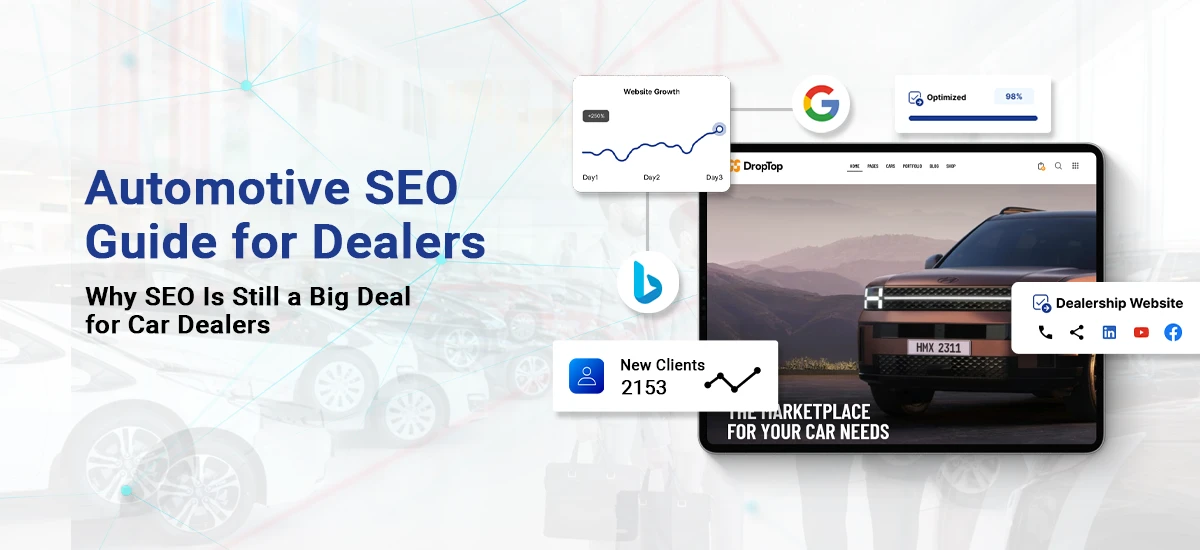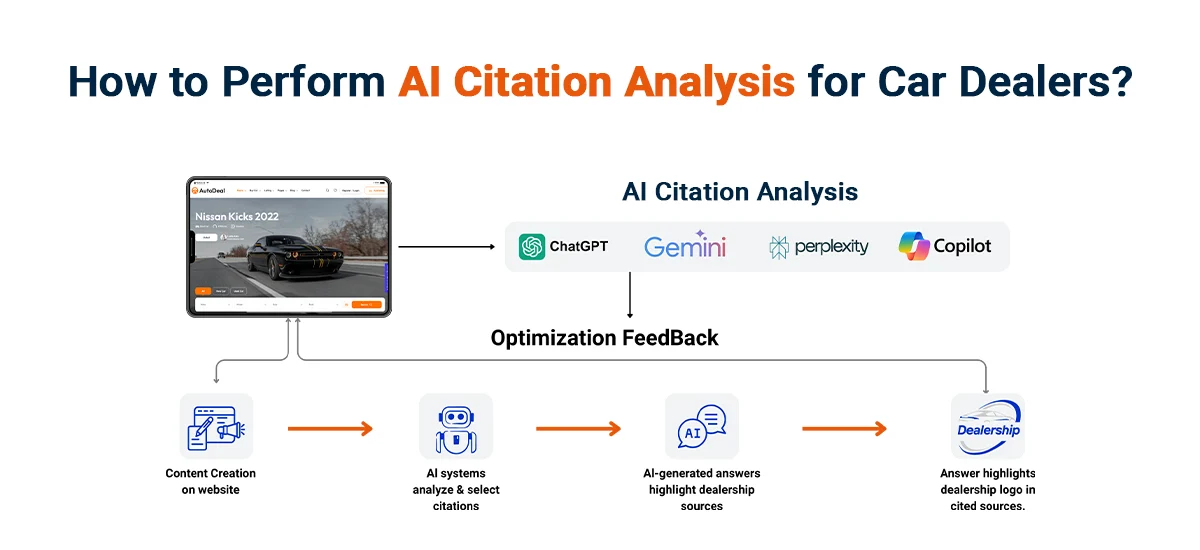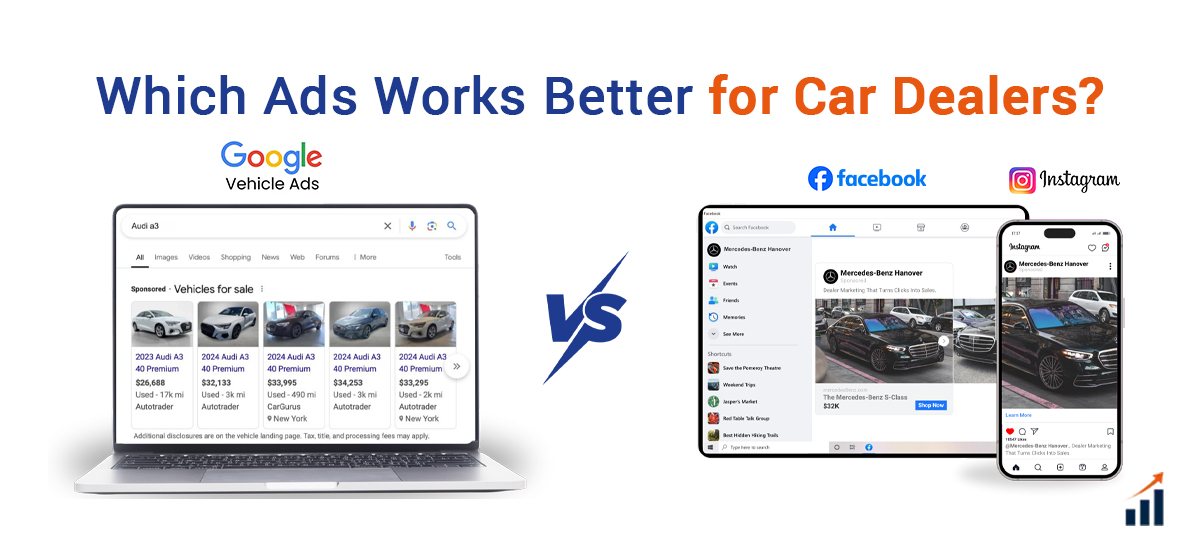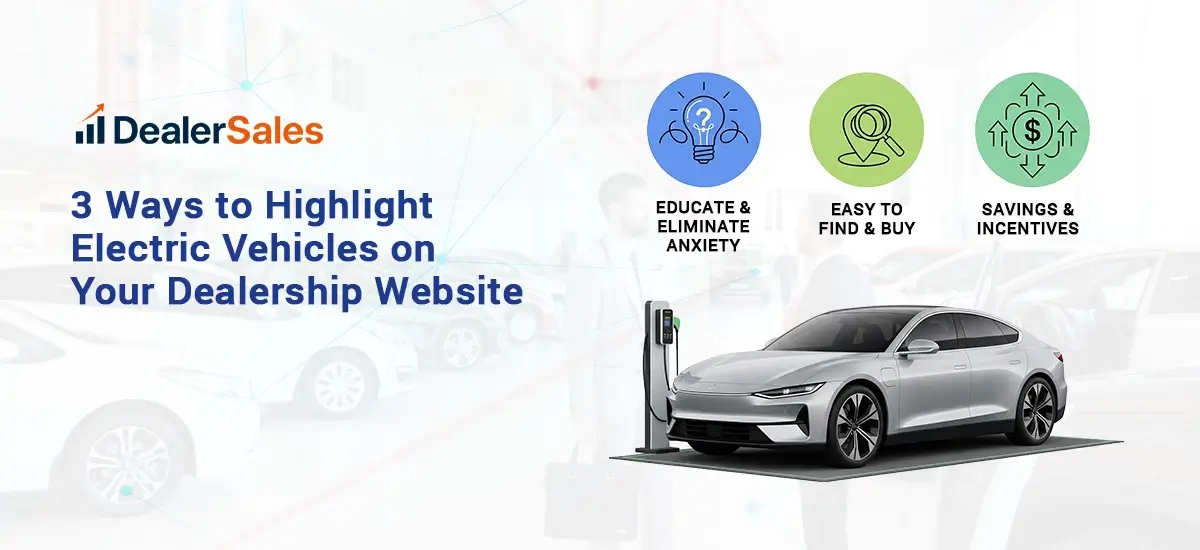Sure, AI and ads get a lot of attention—but organic traffic still brings in serious buyers. Over 68% of
dealership traffic starts with a search, and if you’re not showing up, you’re leaving money on the table.
SEO helps car dealers attract local customers who are ready to buy. When optimized right, your website
becomes your best sales rep—working 24/7 without commissions.
General
Automotive SEO Guide for Dealers

Why SEO Is Still a Big Deal for Car Dealers
The New Search Reality: SGE, AIO & AI Assistants
From Links to Answers
Google’s classic “10 blue links” layout? It’s on the way out. Now, search tools like SGE (Search
Generative Experience) and platforms like Gemini, ChatGPT, and Perplexity are giving users direct
answers.
Your website needs to do more than rank—it needs to teach, answer, and clarify.
What Is GEO and AIO?
- GEO (Generative Engine Optimization): Write content that shows up in AI-generated answers.
- AIO (AI Optimization): Structure your site so AI platforms can understand, index, and surface it
Pro Tip: Want to show up in Gemini or Perplexity results? Use schema, answer-based
formatting, and plain language.
Smarter Keyword Research
Think Like a Buyer, Not a Bot
Car dealer near me” is just the beginning. You need: – Intent-based keywords: “Lease a Toyota Camry
in Nashville” – Geo-specific terms: “Best Honda service Los Angeles” Real questions: “Should I buy or
lease a used SUV today?”
Recommended Tools
- SEMrush or Ahrefs (for competitive insights)
- ChatGPT (for question-based ideas)
- Google Keyword Planner
- Perplexity (for trending phrases)
What To Fix On Your Website (On-Page SEO)
Titles That Sell
Bad: Home – Smith Auto”
Better: Used Trucks for Sale in Denver – Smith Auto Group”
Keep titles under 60 characters and always match them to actual search phrases.
Headers = Structure = Results
Use one H1, then cascade H2s and H3s for subtopics. This helps: – Google crawl better – AI tools chunk
your info clearly – Readers scan your pages faster
Internal Linking = Free SEO Boost
Link related inventory, blogs, and service pages with keyword-friendly anchor text. This improves
crawlability and user flow.
Speed, Code & Mobile: The Technical Stuff
Speed Still Sells
Fast websites convert better. Use Google’s PageSpeed Insights to: – Optimize images – Enable lazy
loading – Minimize JavaScript
Use Schema Markup
Apply these to boost rich results and AI visibility: – Product for inventory – FAQ for service/help
pages – LocalBusiness for your contact page – Breadcrumb for navigation clarity.
ADA & Mobile Friendly
- Follow WCAG 2.2 accessibility standards
- Make sure buttons, fonts, and forms work perfectly on phones
Content That Wins in Google & ChatGPT
Think FAQs, Not Fluff
Write pages and blogs that answer questions people ask. Examples: Best Used Cars Under $20K” –
Pros and Cons of Trading in vs. Selling” – “Chevy Silverado vs. Ford F-150”
Local Pages Work (When Done Right)
Each city page should: – Mention local landmarks/neighborhoods – Include dealership contact info +
map – Be different from other location pages (no copy-paste)
Add Fresh Blog Content Monthly
Topics to consider: – Car maintenance tips – Trade-in guides – New model comparisons – Electric vs. gas
car insights
Off-Page SEO That Builds Authority
1. Show Your E-E-A-T (Experience, Expertise, Authoritativeness, Trustworthiness)
Google—and AI tools—want trustworthy sources. Make sure your dealership displays: – Real author bios
on blog posts (with experience in the auto industry) – Clear About Us pages showing your years in
business and certifications – Testimonials and links to trusted third-party mentions (like news coverage
or awards)
Proving your experience and authority can improve both rankings and user trust.
Get Listed Everywhere
Make sure you’re on: – Google Business Profile – Bing Places – Facebook Business – Yelp, AutoTrader,
Cars.com, Edmunds
Backlink Ideas
- Sponsor a local event and get a mention
- Contribute a guest blog on an automotive site
- Get PR when launching a new service or location
2. Build Strong Review Profiles
Your review game is part of your SEO engine now. Here’s how to make it work for you: – Ask for reviews
from happy buyers (make it part of your post-sale process) – Respond to each review with personalized,
keyword-rich replies – Monitor and manage your dealership reputation across platforms
Consistent reviews = better visibility in local packs and AI summaries. – Ask every happy customer to
leave a review – Reply to every review—good or bad – Include keywords naturally in your responses
Optimize Your Inventory Pages
Each car listing should: – Have a unique title with year/make/model + location – Include complete info:
features, mileage, condition, etc. – Use Product and Offer schema – Contain clear CTAs (like “Book
Test Drive”)
Your Monthly SEO To-Do List
- Update vehicle inventory titles + meta descriptions
- Publish 1-2 blog posts with FAQ or buyer tips
- Fix broken links and audit page load speed
- Submit your XML sitemap to Google
- Respond to reviews and ask for more
- Track keyword rankings and traffic in Google Search Console
How AI Sees Your Dealership Website
Search engines aren’t the only platforms scanning your site now—AI assistants like ChatGPT, Gemini,
and Perplexity are learning from your public content too.
What AI Tools Look For:
- Clear, structured headings (H1, H2, H3)
- Clean HTML with semantic tags (no messy code)
- Answer-based writing that directly responds to common questions
- Accessible and mobile-friendly layouts
- Schema markup to understand what each page is about
When your website is well-structured and informative, these AI engines are more likely to reference
your business in natural language responses and AI search summaries.
Tip: Try asking ChatGPT or Gemini a question like “Where can I buy a used Ram 1500
in Dallas?”—see if your dealership comes up. If not, you have work to do.
Dealership SEO Tools That Actually Help
- Google Search Console – track rankings + fix errors
- Screaming Frog – for technical audits
- NeuronWriter or SurferSEO – content optimization
- Hotjar or Microsoft Clarity – UX testing
Bonus: Quick SEO FAQs for Car Dealers
Q: How long does SEO take for dealerships to show results?
A: Typically 3–6 months to see measurable traffic increases, depending on local competition and
website quality.
Q: Should we invest in SEO if we already run Google Ads?
A: Yes. SEO delivers long-term ROI and organic traffic that doesn’t stop when your ad budget does.
Q: Do AI tools like ChatGPT really reference my dealership site?
A: Yes—if your content is crawlable, optimized, and clearly answers real user queries.
Q: Is blogging still relevant?
A: Absolutely. Google and AI engines still rely heavily on fresh, helpful content.
Final Takeaway: Get Found. Get Clicks. Get Buyers.
SEO is no longer optional. If you’re not showing up in organic and AI-powered search, your competition is.
Start by fixing your basics—then grow with better content, stronger links, and smarter local targeting.
Want help? That’s what we do.
Let’s Talk: Get Your Free SEO Audit
At DealerSales.co, we help U.S. dealers cut costs and win online visibility—without relying only on ads.
Book your free audit and see how your site stacks up.
We’ve helped dozens of U.S. dealerships increase search visibility by over 75% within 90 days. Let us
review your site, identify gaps, and create a roadmap tailored to your market and goals.



